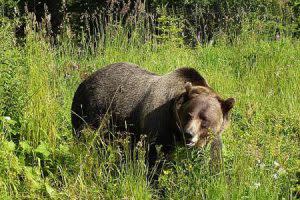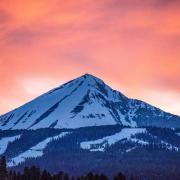The grizzly bear, scientifically known as Ursus arctos horribilis, is an iconic species that inhabits western Canada and the northwestern United States. These large mammals reign as the king of the animal world, triumphantly sitting at the top of the food chain. Despite their fierce reputation, grizzly bears are omnivores, consuming a diet of both plants and animals.
Unfortunately, the US Fish and Wildlife Service lists grizzly bears as a threatened species. Due to human interactions and habitat loss, grizzly population has significantly decreased with approximately 1500 grizzlies remaining in the lower 48 states.
In the 22.5 million-acre Greater Yellowstone Ecosystem, which includes Big Sky, Yellowstone, and Grand Teton areas, National Geographic estimates that there are approximately 600+ grizzlies. This means that Big Sky is home to a significant population of grizzly bears, adding to the area's natural beauty and ecological diversity.
Despite their intimidating image, grizzly bears are fascinating creatures with many unique traits and behaviors. Let's uncover some of the interesting facts about grizzly bears.
- As of 1982, the Grizzly Bear is Montana's official state animal.
- Lewis and Clark gave "Grizzly" bears their name.
- Grizzlies can vary in color, from light cream to brown to black.
- Grizzly bears can weigh upwards of 800 pounds and can measure 5 to 8 feet long.
- They live about 30 years in the wild and 40 years in captivity.
- These bears inhabit prairies, mountains, meadows, forests, and even towns.
- Grizzlies have rounded ears and a short face.
- They are distinguished from black bears by a hump on their back. The hump is a mass of muscles used for digging.
- Grizzlies are solitary animals.
- Grizzly bears communicate with sounds, movements, and smells.
- Grizzlies will rub trees to leave their scent and hair behind.
- Grizzlies can detect food from miles away.
- Grizzly bears hibernate during the long winter months. Sometimes they sleep for up to 7 months a year!

- Females are not able to reproduce until they reach 4-5 years of age.
- After mating in the summer, the embryo goes through "delayed implantation." This process ensures that the bear is able to gain enough weight before hibernation to ensure a successful pregnancy.
- Gestation varies from 180 to 270 days depending on the delayed implantation.
- During hibernation, a grizzly's heart rate slows from 40 beats per minute to 8 beats per minute. They do not go to the bathroom at all during hibernation.
- Female bears can give birth to cubs while sleeping - usually in January or February.
- Cubs are born blind, hairless, and toothless.
- Litters of grizzly cubs include anywhere from 1 to 4 cubs.
- Cubs stay with their mother for 2-3 years.
- Half of all cubs do not survive past the first year.
- Mothers are very protective of their cubs.
- Grizzlies can eat up to 90 pounds of food in a day
- Grizzlies are omnivores and will eat anything that is nutritious - nuts, fruit, leaves, roots, salmon, rodents, sheep.
- A grizzly's claws are about the size of a human finger.
- Grizzlies can run up to 35 MPH (50 KMH).

While grizzly bears generally avoid human contact, it's important to be bear aware when in their territory. Follow safe travel practices in the backcountry by making noise, traveling in groups, and always carrying bear spray. Properly storing food in bear country is also essential.
Encounters with grizzlies are rare, but if you do come across one, exercise extreme caution. Maintain a safe distance, avoid direct eye contact, and make yourself appear large. Slowly back away and be prepared to use bear spray if necessary. Education on bear encounters and how to properly use bear spray can be found with our friends at Hey Bear.
The interesting facts about grizzly bears in this post came from these sources:

